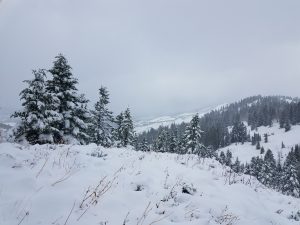Wyoming Winter Range and Wildlife Conditions Update
As western states continue to accumulate snowpack in the high country, there has been a great deal of buzz about threatening winter conditions for wildlife. Over the past couple of weeks, we’ve received many questions from clients about our winter conditions here in Wyoming and how that’s impacting wildlife. Here’s a quick update.
First, it’s important to know that when talking about tough winter conditions, big game animals can’t be lumped together. Winter affects each of them very differently. In Wyoming, winter conditions do not affect elk in any significant way. Elk in Wyoming are fed every year. They spend their winters on feed grounds and will not hesitate to migrate very long distances if needed. There’s never really any issue as far as elk are concerned.
Among our big game species, antelope are by far the most fragile. But antelope hunters should be relieved to know that most of our antelope country, which dominates the central and eastern parts of the state, has seen an extremely mild winter. If you speak with anyone along the eastern flank of the Rockies, you’ll hear the same story – this winter has been one of the mildest we can remember. Temperatures throughout February have been warm with little significant snowfall.
For wildlife central and eastern Wyoming, it has been the perfect winter. There’s plenty of snowpack up high for spring and summer runoff, but very little winter weather out east. Both antelope and mule deer were in good shape going into winter. And with very green range conditions this spring, horn and antler growth should be excellent.
 This year’s heavy snowpack has fallen in the high country and in isolated areas in western Wyoming. Mule deer hunters in these higher elevations, like our camps in the Greys River region, could eventually see the impacts. But we won’t know for the next 3-4 years. In harsh winter conditions, the first victims among mule deer are fawns, then yearlings, and then the old. Additionally, does carrying twins are more likely to lose one of those fawns and only retain one.
This year’s heavy snowpack has fallen in the high country and in isolated areas in western Wyoming. Mule deer hunters in these higher elevations, like our camps in the Greys River region, could eventually see the impacts. But we won’t know for the next 3-4 years. In harsh winter conditions, the first victims among mule deer are fawns, then yearlings, and then the old. Additionally, does carrying twins are more likely to lose one of those fawns and only retain one.
Does and bucks in the prime age-classes are the ones that will survive this winter. Hunters in 2017 are not likely to see any diminished quality among trophy high-country mule deer. However, there’s a chance that in a few years we could see a dip in those trophy age-classes that would have been fawns or yearlings this year.
For information on our hunts, be sure to check out our website at HuntWyo.com or give us a call at 307-266-4229.


